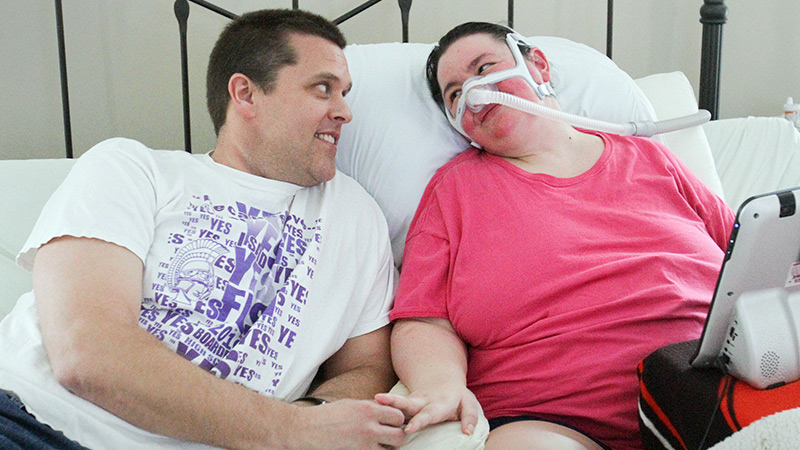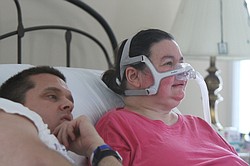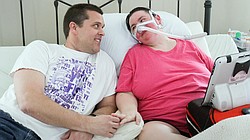ALS takes its toll on Christine, family members

Related Stories
By Jessica Hardin
BOARDMAN
Describing ALS, Christine Terlesky said: “It just takes.”
As she sat upright in bed, unable to move, she described the first year of her illness.
“The first year I had it, it sounds weird, because I’m in a lot worse condition, but it was the hardest,” she said, pausing for breath between words. “Because I had to adjust that my life was never going to be the same.
“I came to the reality of how much I was going to lose.”
A teacher and an athlete in 2013, ALS took Christine’s ability to run. Then the job she loved. Then her insurance.
Christine Terlesky Battles ALS

Christine Terlesky of Boardman has been battling ALS for six years.
“It’s like all of a sudden you weren’t a person anymore,” Christine said.
Her oldest son Brian was 13 when his mom got sick. He remembers when she was healthy.
Brian, who plays golf at Youngstown State University, smiled warmly as he told the story of his mom taking over as caddy after a tiff with his dad at a tournament in Florida.
“I woke her up at 6 a.m., and she caddied for me for 27 straight holes,” he said.
Now, she’s not even able to watch from the sidelines.
“It took a while for me to adapt, because I was very independent. My marriage was a partnership. We each carried our own weight. And now I depend on everybody else for everything,” Christine said.
Christine Terlesky ALS Series 3

NOTHING YOU CAN DO
In some tellings of her diagnosis, Christine’s voice cracks. She remembers breaking down in the doctor’s office and sobbing with her husband as they drove home from the Cleveland Clinic.
In other tellings, she is visibly frustrated. She recalls bouncing from doctor to doctor before finally being told that there was nothing anyone could do.
When doctors ruled out Multiple Sclerosis, she hoped for a tumor on her spine.
“Everybody prayed for cancer,” Christine said, incredulously.
For a self-described fighter, ALS is an impossible pill to swallow.
There is no treatment. Doctors don’t even know what causes it.
So a diagnosis is delivered with resignation and utterly without hope.
“You want to do more, but you can’t,” said her family doctor, Nino Rubino. “We’re handcuffed.”
He helped Christine search for clinical trials. The few available had exceptionally specific inclusion criteria.
“There was nothing I could do. Nothing I could try. Nothing I could get into, even if I was willing to,” Christine said.
Even in 2013, research had only produced one ALS drug – Riluzole – in 1995. If effective, doctors said it could increase survival by two to three months.
The side effects: dizziness, nausea, painful urination, diarrhea and a “general feeling of discomfort or illness,” according to the Mayo Clinic.
By summer 2014, it was impossible to turn on the television or scroll through Facebook without seeing videos of everyone from Oprah to LeBron James getting drenched in ice water.
The ice bucket challenge was a game-changer for ALS awareness.
Christine’s Facebook wall was soon flooded with videos of friends, family and acquaintances pouring a bucket of ice water over their heads.
The viral sensation raised $150 million for ALS research. That’s nearly twice the amount the government provided in 2015.
And while the phenomenon made ALS a household acronym, Christine was too far into the illness to benefit.
In 2017, the FDA approved Edaravone, a drug that is administered through an IV infusion 10-14 days in a row, once a month.
If effective, it could reduce the decline in daily functioning. But, “it doesn’t make you better,” Christine said.
The side effects: bruising, swelling and shortness of breath.
For Christine, an unreliable new medication would likely only increase pain and medical expenses.
“To get her hopes up so high then to get a denial is more devastating than not ever thinking you have a chance,” Christine’s mom Judy Moschella observed.
‘WE HAVE AGED’
Christine doesn’t sugarcoat what ALS has done to her. Still, she maintains the disease is “tougher on the family.”
In the past six years, Christine’s family members have witnessed their wife, daughter, mother and sister become trapped in her body. And there’s nothing they can do about it,
“When she has bad days, I am so down,” said Christine’s 74-year-old mother-in-law Mary Lou Terlesky. “My husband and I – I am serious – we have aged. In the last six years, we have aged.”
Christine’s youngest sister Jolene Moschella Ross half-joked that she copes with medication and the occasional cocktail.
Her middle sister Nadine Moscella-Colla said she just stays busy.
“I think I engross myself in work to not be in reality,” Nadine said.
Continuing to work has helped Judy. “That keeps me normal,” she said, adding long car rides also help.
“I just like to go and get in my car and put the windows down and drive,” Judy said, surrounded by her family one Sunday afternoon after dinner.
Her husband Ron – both famous and infamous as a fiery basketball coach – struggles to see his daughter like this.
The man who told stories and joked at dinner is gone. This version of Ron is raw and defeated.
“I go there once in a while. I can’t take it,” Ron said. “When I go, it just upsets me, and I’ll sleep until one in the afternoon. I just don’t want to be awake.”
ALS has changed the way Christine’s family looks at the world.
“You just think your worst day is never [as bad as] her regular day so everything is put in perspective constantly,” Nadine said. “The way I thought about everything was, ‘Unless you’re dying, shut up.’ You know?”
Watching their mother decline has given Christine’s kids an intimate understanding of life with a disability.
Their interactions with children with disabilities, such as their cousin who is autistic, conveys that unique compassion.
“I love seeing that,” Christine said.
ALS AWARENESS
Anyone can get ALS, and it’s less rare than people think.
When Christine was diagnosed at 41, she thought she was too young to get ALS. Her doctor told her that he had recently diagnosed a 21-year-old.
“My argument is that it’s not rare. People just die so fast,” Christine said.
As a result of these misconceptions, many are misdiagnosed, she argues.
“I had hand tremors for a whole year before I got diagnosed,” Christine recalls with frustration. “They told me there was nothing wrong with me.”
Christine also suspects that the ugliness of the disease accounts for a lack of advocacy.
ALS patients often die quickly. Making advocates out of family members and caregivers is uniquely challenging.
“They need a lot of healing after the person is gone. It takes everything out of them,” Christine said.
She gave the examples of caregiver groups on Facebook.
“It’s a great support group. But as soon as their person dies, they drop out. It’s just too painful,” Christine said.
She hopes that her family will be different.
She wants her children to be advocates.
And it looks like that will be the case.
In a project she cleverly called “Slime ALS,” 10-year-old Emma sold homemade slime at school and donated the proceeds to ALS research.
DAY BY DAY
Every 90 minutes, someone is diagnosed with ALS. That person’s average life expectancy is two to five years. Christine is in her sixth year.
“ALS affects the nerves in the brain and spinal cord. You lose muscle function,” said Dr. Rubino. “When you lose control of your muscles, you lose the ability to breathe.”
Most people with ALS die of respiratory failure.
The mask Christine wears blows air into her lungs, to help her take deep breaths. When she loses the ability to breathe, she could opt for a breathing tube.
With the knowledge that this disease is killing her, Christine could be miserable. She could shrink into herself; letting the dark cloud of this diagnosis snuff her vitality.
“She could be sad every single moment,” said her son Brian.
But she’s not.
She fights a losing battle with unwavering resolve. She fights to watch her children grow up. She fights for others with ALS.
When she dies, she has even agreed to donate her brain and spinal cord for study.
When Christine was diagnosed, her dad prayed she would outlive the bleak prognosis.
“But God let her go six,” Ron said. A flicker of hope lifted his voice. “And he might let her go another 10. You never know, because she’s strong enough to do it.
“Up here,” he said, pointing to his head.
Christine doesn’t think as far ahead.
She lives day by day and derives joy out of moments of goodness, such as Brian’s return from college and Emma’s school project.
A few days ago, a former student sent Christine a message on Facebook. When he was in high school, his brother was murdered. Christine could see that he was struggling. She showed him that knowing tenderness of a special teacher.
She wrote him a note when he graduated. In his message to Christine, he told her that his mom had it framed.
“He said, ‘Whenever I felt like giving up, I always read your letter,’” she retold in a shaky voice, with tears streaming down her face.
THE END
As Christine has said about ALS, “It just takes.”
ALS has indeed taken almost everything from Christine.
One day, it will take her breath.
But she will live.
In the laughter of her sisters when they tell stories about her.
In the faces of her children at Sunday dinner.
In the framed letter on her student’s wall.
No disease, not even ALS, can truly take Christine away.
 43
43
